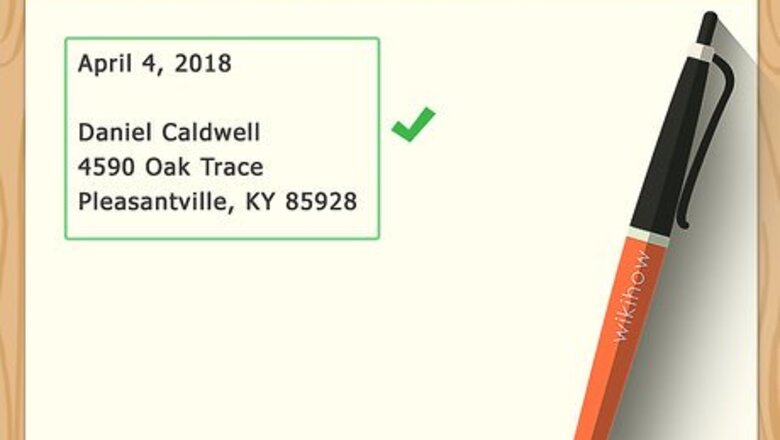
views
X
Expert Source
Alexander Ruiz, M.Ed.Educational Consultant
Expert Interview. 18 June 2020.
Then, write your letter in a formal style and send it off with tracking to ease your mind.
Following Formal Letter Writing Conventions
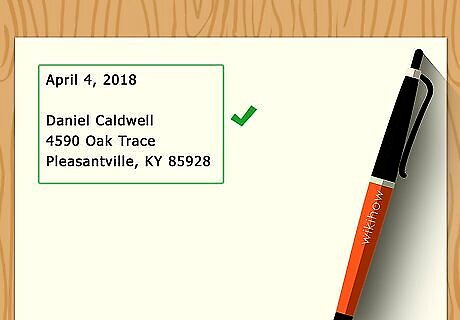
Prepare a header section. The date should go in the upper right corner of the page. Skip one line below it and then type out your address, also justified to the right. Then, skip another line and place your recipient’s full address flush with the left hand side of the page. If you are sending your request via email, you can omit the date and address portions and start with your salutation. However, make sure to use an effective and clear subject line. For example, if you are emailing a professor, your subject line might read, "Mike Smith HIST 359 Paper Extension Request."
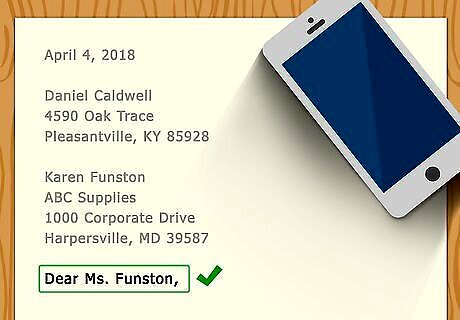
Employ a formal and full salutation. Start my typing “Dear” and then follow with their title and last name. For example, “Dear Mr. Brady” or “Dear Ms. Smith.” Some titles can be more complicated, such as “Dear Professor Montgomery” or “Dear Senator Smith.” Even if you know them informally, this is an official request so keep the tone and content formal. Do not write “Hi, Jim,” for example. Try to find some specific person that you can address your letter to. Otherwise, it can appear like a form letter. For example, “Dear Senator Smith,” is preferable to, “To Whom It May Concern.”
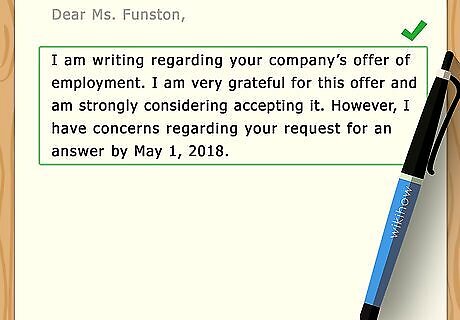
Use a concise paragraph format. The body of your letter should be somewhere between 1-3 paragraphs. In many cases, you can open with 1-2 lines, explain your request in 2-4 lines, and conclude in 1-2 lines. If you need to expand to a full three paragraphs, simply separate the introduction, body, and conclusion. To open your letter you might state, “I am John Smith a student in your HIST 456 MWF morning class.” This will jog your professor’s memory and save them time looking you up.

Pay attention to your concluding remarks. Don’t disregard the importance of a solid conclusion. Use your final sentences to restate your case (in one line) and to thank them for their time. You might write, “I appreciate your consideration of my request.” It is best to close with an official “sign off” before your name. Some of the better options are: “Sincerely” “Best” “All the Best” “Best Regards.” If you need a reply by a certain time, you should include that information at this point as well. You can always pair it with your thanks. For example, “Thank you for your consideration and I look forward to hearing from you next week.” Just be careful not to appear overly pushy.
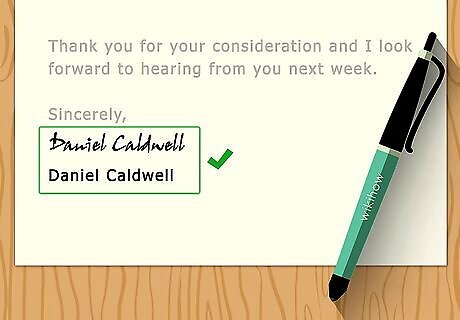
Include your full name and signature. Below the “Sincerely,” leave 3-4 lines blank. Then, type your full name and justify it to the left. Use the blank space to sign your name in pen. If you plan to email your letter, you can delete those spaces and go directly to a typed name.
Crafting the Content of the Letter

Write the letter as soon as you can. As soon as you know you will need an extension, immediately begin preparing your letter. You need to give the recipient as much time as possible to make a decision about your situation. You also want to appear prepared, despite asking for an adjustment to the schedule.

Determine how much extra time you will need. Consider all factors and submit a realistic request. If you ask for too little time, you may need to request another extension. Missing deadlines should be avoided whenever possible. So, it’s best to overestimate a little. Depending on the situation, you might need to consider your letter as part of an ongoing negotiation. In that sense, it is better to ask for a longer amount of time so that you can compromise and meet in the middle. Gauge your pace based upon your current progress and what parts of the project have yet to be completed. For example, if you have worked on a consulting project for three months you should have a pretty good sense of how much is left to do. Be aware of the time constraints facing the recipient as well. They may be under their own deadlines that will now need to be pushed back. For example, college professors are often required to submit midterm grades and schedule their paper deadlines accordingly.

Be aware of the existing rules. Verify the current deadline before you ask for it to be altered. You don’t want to appear disorganized by requesting an extension when you don’t understand the current situation. For example, some government entities require that you submit your request within 24 hours of initial contact with them. If this doesn’t work for you, then you can always cite the tight turn-around schedule.

Include a sound explanation for your request. You are taking the time to craft the letter and your recipient will then take the time to read it, so make it worthwhile. Carefully consider your true reason for needing the extension and honestly convey this to your reader. Don’t lie or exaggerate as this will only hurt your case. A good reason might be the desire to be thorough or cautious in your work. For instance, if you are completing a project that could potentially impact the safety of others, pointing this fact out when asking for extra time could work in your favor. If you have multiple reasons for your request, choose the best one and focus on it. For example, if you are delaying a job offer you might want to tell them that you would like to conduct additional research into the transfer costs (if this is indeed true) instead of letting them know that you are also waiting on another offer.

Provide a few carefully chosen details as part of your request. Details will give your letter a sense of legitimacy and craftsmanship. This is especially important if you are submitting your letter to a government panel or some other group that you have never met personally. For example, if your grandfather dies two days before your college essay is due, it is best to describe the incident as a “family emergency” as opposed to a general “emergency.” You may also want to mention his passing and some information about your travel arrangements. Have your paperwork in order before submitting any request. You may need to lay out a timeline of prior actions and applications, especially if dealing with the government or another official entity. Showing that you have followed all steps of the process up until this point can only work in your favor.
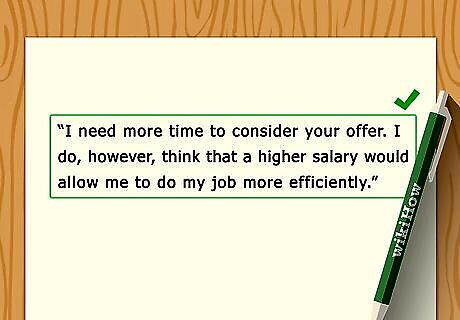
Stay positive in tone and content. No one wants to read a letter that is one whiny line after another. Instead, describe negative events quickly and concisely and move on to the positive solution that you propose. For example, if you think that an initial salary offer is too low, you might write, "I need more time to consider your offer. I do, however, think that a higher salary would allow me to do my job more efficiently."

Proofread your letter prior to submitting it. Give yourself at least a few minutes to read over your letter before you send it off. Look for editorial mistakes and typos. Run the grammar and spell checking software on your computer. Send it off to a trusted friend for a quick second read through. Don’t rush or skip this process or you will appear sloppy and it could impact the final outcome.
Sending the Letter to the Recipient

Make or save a copy of your letter. As soon as you’ve proofread your draft, and prior to sending it off, take a photo (transfer to pdf), save a draft online, or make a traditional copy of your letter. You may also want to write down the mail off date if it doesn’t match the one at the top of the letter. File this copy somewhere safe for your personal record.

Place it in the standard mail. Take your letter to the local post office, give it to your mail carrier, or drop it in a post box. If you want more assurance that your letter was received you can always request extra tracking services for an additional fee. If you are going to mail off a hard copy of your letter, make sure to print it out using a high quality printer with a good ink cartridge. A handwritten extension request is generally not acceptable.
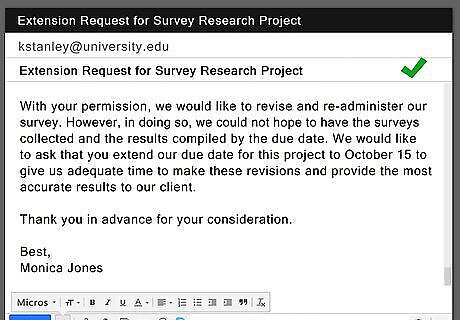
Email your extension request. This is the probably the best way to send your request as it requires little time and is very reliable. Verify your recipient’s email address before sending and include your identification number, if relevant, in the subject line. Your recipient may be able to see the exact time that you sent the email. Be aware of this if you like to send off emails very late at night. Keep your email formal and that includes the address that you use as well. Send this email from a professional-sounding account. For example, sending a work email from “[email protected]” is appropriate. If you send your letter via fax, make sure to hold on to the confirmation page showing that your transmission was successfully sent and received.

Make a phone call instead of writing. If your need for an extension is urgent or very last minute, you may be better served by talking to them in person or by calling. If this is the situation, continue to act formally and state your case in an organized way.




















Comments
0 comment